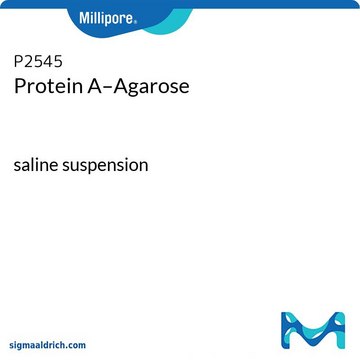P3391
Protein A-Sepharose™ from Staphylococcus aureus
lyophilized powder
Synonym(s):
Protein A–Agarose
About This Item
Recommended Products
form
lyophilized powder
Quality Level
packaging
glass bottle of 1 g
glass bottle of 1.5 g
glass bottle of 250 mg
glass bottle of 5 g
storage condition
do not freeze
extent of labeling
3 mg per mL
technique(s)
affinity chromatography: suitable
color
white to gray
matrix
Sepharose CL-4B
matrix activation
cyanogen bromide
matrix attachment
amino
matrix spacer
1 atom
capacity
≥16 mg/mL binding capacity (human IgG)
solubility
water: 1 g/L at 20 °C
suitability
conforms to structure for swelling capacity (1g swells to 4 to 5 mL)
storage temp.
2-8°C
Looking for similar products? Visit Product Comparison Guide
General description
Application
- for immunoprecipitated placentas for protein and RNA analyses using Western blot technique.
- in chromatin immunoprecipitation to understand the link between Mediator and remodelling of chromatin structure at specific promoters.
- as lysis buffer to remove endogenous G-type Igs in protein extraction of brain samples from female rats.
- in immunoprecipitation of [32P] phosphomyristin C of rabbit antiserum, to study the down-regulation of protein kinase C (PKC) and phosphomyristin C (PMC) during T-cell development.
Quantity
Physical form
Legal Information
related product
Storage Class Code
11 - Combustible Solids
WGK
WGK 3
Flash Point(F)
Not applicable
Flash Point(C)
Not applicable
Personal Protective Equipment
Choose from one of the most recent versions:
Already Own This Product?
Find documentation for the products that you have recently purchased in the Document Library.
Customers Also Viewed
Protocols
To determine the molecular weights of protein antigens, to study protein/protein interactions, to determine specific enzymatic activity, to monitor protein post-translational modifications and to determine the presence and quantity of proteins.
Our team of scientists has experience in all areas of research including Life Science, Material Science, Chemical Synthesis, Chromatography, Analytical and many others.
Contact Technical Service









